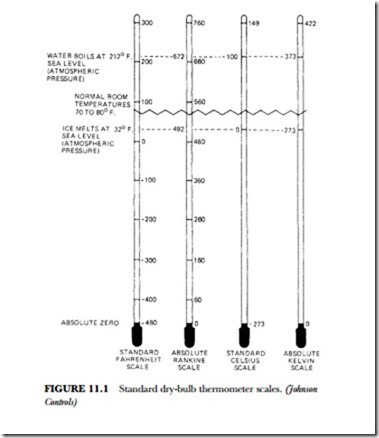TEMPERATURE
Temperature is defined as the thermal state of matter. Matter receives or gives up heat as it is contacted by another object. If no heat flows upon contact, there is no difference in temperature. Figure 11.1 shows the different types of dry-bulb thermometers. The metric centigrade scale is now referred to as degrees Celsius. The Celsius scale is divided into 100 degrees, from the freezing point of water to the boiling point.
American industry and commerce still use the Fahrenheit scale for temperature measurement. However, the metric scale is becoming more accepted. The Fahrenheit scale divides into 180 parts the temperature range from the freezing point of water to its boiling point. The Fahrenheit temperature scale measures water at its freezing point of 32 degrees and its boiling point of 212 degrees. The pressure reference is sea level, or 14.7 pounds per square inch.
Absolute temperatures are measured from absolute zero. This is the point at which there is no heat. On the Fahrenheit scale, absolute zero is -460 degrees. Temperatures on the absolute Fahrenheit scale (Rankine) can be found by adding 460 degrees to the thermometer reading. On the Celsius scale, absolute zero is
-273 degrees. Any temperatures on the absolute Celsius scale (Kelvin) can be found by adding 273 to the thermometer reading (see Figure 11.1).
Absolute-zero temperature is the base point for calculations of heat. For example, if air or steam is kept in a closed vessel, the pressure will change roughly in direct proportion to its absolute temperature. Thus, if 0-degree F air (460 degrees absolute) is heated to 77 degrees F (537 degrees absolute) without increasing the volume, the pressure will increase to roughly 537/460 times the original pressure. A more formal statement of the important physical law involved states that at a constant temperature, as the absolute temperature of a perfect gas varies, its absolute pressure will vary directly. Or, at a constant pressure, as the absolute tem-
perature of a perfect gas varies, the volume of the gas will vary directly. This statement is known as the Per- fect Gas Law. It can be expressed mathematically by the following equation:
It is sometimes necessary to convert from one temperature scale to another. In converting from the Fahrenheit to the Celsius scale, 5/9 degree Fahrenheit is equal to one degree Celsius. Or, 9/5 degree Cel- sius is equal to one degree Fahrenheit. Equations facilitate converting from one scale to the other.
For example, convert 77 degrees F to degrees C. Use the following formula:
Temperature-conversion tables are also available. A calculator can be used for the above temperature conversions. If a calculator is used, the number 0.55555555 can be substituted for 5/9. The number 1.8 can be substituted for 9/5.


